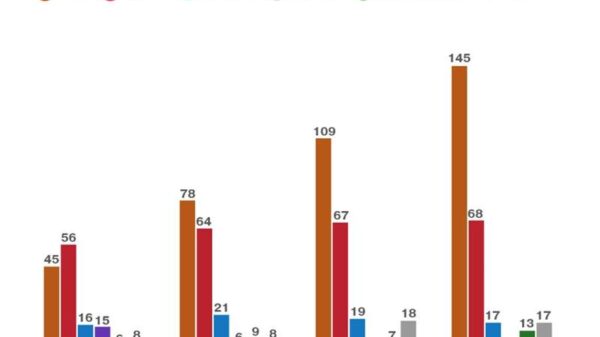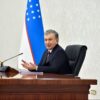Two Russian tanks, several armoured personnel carriers, and several turrets are evidence of the violence. The charred remains a soldier can be found in a field close to the Russian soldier.
Valeriy Hudym, an elderly resident, stated that mortars were strong enough to cause fear in the cellar. Two days ago, Ukrainian soldiers retook Lukyanivka from the Russians after a five-hour battle.
“Tanks were firing machine guns and artillery. Hudym said that anything was possible. In the battle to retake the village, two Ukrainian soldiers were involved. The fighting was intense, they said. Heavy clashes broke out in defense of Kyiv’s capital, a month after Russia invaded Ukraine.
These villages and towns are often forgotten in history, but they have been the sites where Russian advances were stopped by mobile Ukrainian units equipped from abroad with anti-tank weapons.
Moscow stated Tuesday that it would drastically reduce its operations around Kyiv to facilitate dialogue.
Residents of Lukyanivka, two hours from Kyiv, recall calling for the evacuation Russian troops who were occupying them.
“I have a neighbor named Svitlana. She called them out directly and said, “Guys! Go home!” Hudym said, “You’ll be killed here.”
The reverse happened in the area surrounding the capital’s north half. After losing the territory within the first month, Ukrainian troops reclaimed it in small battles. They did not win a decisive victory.
The Russian defense ministry requested comment on the military situation in Kyiv but was not immediately responded to.
The victories were however a psychological blow against an even stronger enemy. They demonstrated that agile units with an excellent understanding of the surrounding area can push back or defend lines.
Experts stated that they also serve strategic purposes, keeping the Russian artillery further from the city’s center and preventing invading armies encircling Kyiv.
Heavy bombardment of cities such as Kharkiv and Mariupol has been carried out to stop Russian ground advances. This is part what Pentagon and other Western military officers call Russian frustration over the slow progress.
According to city officials, Kyiv was also struck by shells and missiles. At least 264 civilians died in the attack. Witnesses claim that the destruction to the city’s center is smaller.
Russia refers in particular to its actions in Ukraine as a “special operation” which aims to demilitarize the neighboring country. It denied it was targeting civilians.
“We drove out Russians. The Russians are being moved just a few kilometers away,” Marat Sifulin, a member of the Ukrainian “Brotherhood battalion,” said. He was part of an attack that took place between noon and dusk.
William Burns, the Director of the CIA, said in March that Russian President Vladimir Putin had intended to seize Kyiv in two working days following the February 24th invasion.
Putin and Russian officials have repeatedly said that Russia’s military intervention against Ukraine was in line with their plans.
Two setbacks in the beginning indicated that it would be difficult for a Russian force with around 190,000. Some diplomats had already estimated this number prior to the war. Russia has yet to provide a number for its troops in Ukraine.
Russian paratroopers attacked Hostomel Airport on the first day, which was a bridgehead northwest of Kyiv. According to Wall Street Journal, the Russian advance towards capital was slowed by heavy fighting in the region.
Satellite imagery also captured a huge column of military hardware, measuring 40 miles (64 km) in length and coming from the same direction.
It was viewed by some Western defense officials as a significant threat to Kyiv in the early days of war. The group dispersed by March 10, although some vehicles moved into nearby villages.
A senior U.S. defense official said that Russia’s march to Kyiv (which included the convoy) was stalled because of logistical problems, including low morale and fuel shortages.
With anti-tank weapons and some of the U.S.-made Javelin system, small units of Ukrainian troops attacked tanks columns. This was another contributing factor to Russia’s military fall.
After being captured by pro-Ukrainian troops, a convoy of Russian tanks was repelled in Brovary, to the east.
Bucha, the mayor of Bucha, was captured filming scenes of damaged tanks and armoured cars, despite being under heavy attack.
In an attempt to stop the enemy’s advance, Ukrainian forces destroyed a bridge linking northwestern cities with Kyiv in Irpin. The mayor of Irpin claimed that Ukraine had regained complete control Monday.
Due to the Russian weakness and flexible defense strategy, there have not been any significant advances against Kyiv.
Although only half the 3.4 million residents who once lived in peace are still alive, there are signs that normality is returning to the streets. There are some shops, restaurants, cinemas, and people enjoying the sun in the parks.
The Russian General Staff’s Head of the Main Operational Directorate expressed hope that the capital’s immediate threat might be decreasing last week.
He said that the first phase of Ukraine’s operation was complete in large parts and that Russian forces would now focus on the Donbass to the east.
This confirmed Western intelligence that Russian forces abandoned active attempts to take Kyiv after suffering heavy losses and stubborn Ukrainian defenses.
Many roads leading to Kyiv are littered by debris and homes that have been destroyed. It is difficult to know when and where the next missile will strike.
Hanna Yevdokimova (92), said that the invasion was the third conflict she had witnessed after the Soviet-Finnish Winter War (1939-1940), and World War Two, when she saw German troops pass through Krasylivka.
Last week, missiles destroyed her home. A 100m long fragment of a Russian Kalibr missile was found in the backyard of a neighbor. It measured 328 feet.
“What are you capable of doing?” She stated that all she wants to do is rebuild her house so she can live in peace.
Residents of Lukyanivka claimed they were held for almost a month as virtual prisoners by Russia under Russian occupation. Their mobile phones were confiscated and their movement was limited to armed escort.
They are now free to leave their homes that have been badly damaged and can come back as often as they wish.
Last week, heavy shelling occurred near Makariv West Kyiv. This area remains in dispute. Vadym Tokar was the mayor of the city. He travelled through the villages wearing military fatigues and distributed pensions.
Vasyl Chaylo, a Peremoha journalist, described Russian conscripts as he was afraid. They were lacking food and disciplined by professional fighters.
They fear. He stated that they may not want fight and want to surrender. They are kept in line by special forces.
Chaylo stated that he also asked the tank crews stationed outside Chaylo’s home how long they would dry rations. They were informed it would take a week. “They arrived at our house on the eighth of the month and said they had nothing to eat.”
Russia’s defense minister has now admitted that conscripts were involved in the conflict, despite earlier denials by the Kremlin and military authorities. The ministry did not immediately respond to a request for comment regarding rations.
Halyna Shybka worked as a nurse in a military hospital close to Kyiv for 25 years. She refused to listen to her grandchildren. She stayed with Mykola in Kalynivka, where she and her grandchildren have lived since 1974.
She stated that they tried to persuade us to leave in all possible ways, but we wanted stay” and she started to make tea in her small kitchen. She was clearly unhappy by the sound of rumbling Ukrainian artillery firings in her background.
“This is our country. We are not leaving.”
This article is shared:































